THE PIONEER MEALEY FAMILY
by
Mona Hyler Waibel
![]()
The first settlers chose the Willamette Valley, where they could easily grow crops and settlements were already established.
Later the valley became very populated and the settlers looked to the foothills for available land, finding the beautiful Sweet Home Valley, which was ideally situated both for farming and living off the forest. Indeed this small village, Sweet Home, was isolated from the rest of Linn County.
Many of the settlers’ wagons simply broke down, and they could go no further. The hardy travelers would cut small logs to build a cabin, and then later they would split thin shakes for the roof. Most travelers carried waterproof canvas, which was always available from the wagon’s covering, to cover the cabin until a roof was completed.
Men learned to log, prompted by the need to clear the land and build their cabins. The cabin logs were cut into lengths with a maul and wedge. Notching the logs took time too, and moss made the cracks partly wind-proof and the cabin warmer. It was hard work being a pioneer.
The men cleared the land to grow their crops; of course, hay was needed for their livestock, and perhaps they needed hay and vetch for the smaller farm animals. Crops were planted the difficult way, usually with a hoe and much later with a horse-drawn plow.
Starting a new town site began by cutting the Douglas fir trees and establishing a sawmill, run by water power or steam. The Ames family’s sawmill was quite productive. But people were arriving so quickly, there were not jobs for everyone immediately. Most families did come with some cash to last that first winter, but by the arrival of spring, they would be getting desperate.
Families looked at the groceries and didn’t have the money to buy. Store proprietors sold on a cash-only basis – no credit allowed. Jobs and income were needed by every family. Wagons arrived with hungry customers without money, who kept looking for work. In the spring, gardens were planted and it would be a long wait before there was a crop. Those who found work were fortunate. Heating was always handy, with a pot-bellied stove and gathering scrap wood from the sawmills. Times were tough.
More settlers – the Keeneys, Weddles, Mealeys and Paddocks –
arrived during the period of 1865-75 and finally a school was built.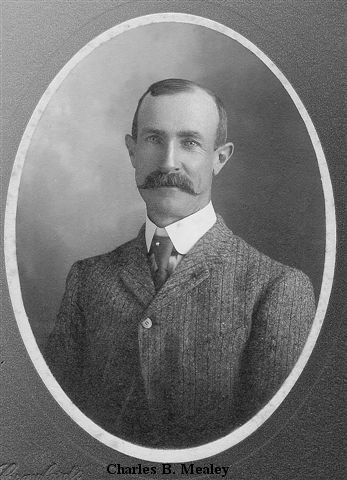
Charles Mealey, who had traveled from Ohio to Oregon by way of covered wagon in 1852 at age 21, homesteaded in the 1870s on 160 acres on Wiley Creek on Moss Butte east of Sweet Home. Charles purchased lumber for his home from the Wiley Sawmill and built a roadhouse for travelers on the Willamette Valley and Cascade Mountains Wagon Road. Then he built a large barn for storing hay and feed for the traveler’s horses. He had several more good ideas, by opening a general store, and operating the local post office.
But Charles had gold fever and was anxious
to head out into Central Oregon where tales of gold strikes reached his
ears. His dream failed, the gold was meager and costly to mine. He sold the
claim for $100.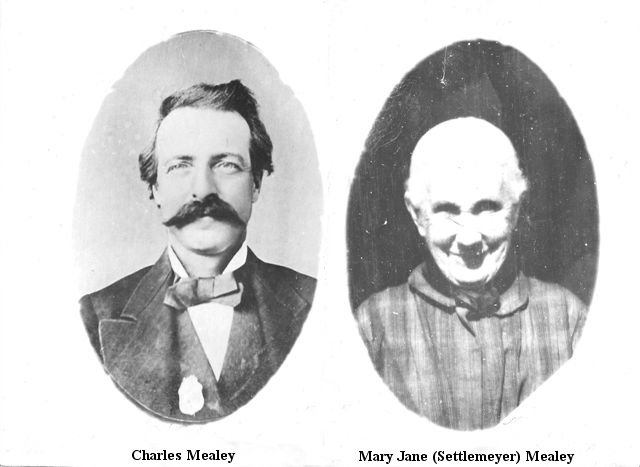
He married Mary Jane Settlemeyer and they had five sons and two daughters: Thomas, George, Charles, Judd, William Ralph, Alice Jane Mills and Joy Elizabeth Mills. The children went to the nearby Sunnyside School. They all became active leaders of the community as adults and remained in this area most of their lives.
Thomas Mealey, Charles’ oldest son, became
a pharmacist and tried running a drug store in
Albany. But
he enjoyed the outdoors and gave up the drug store.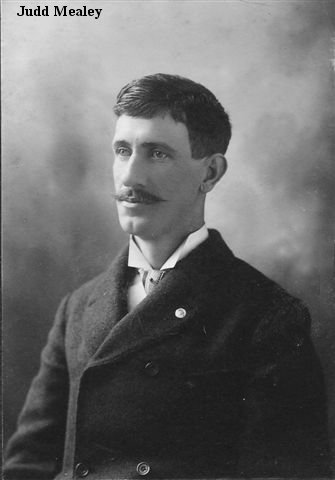
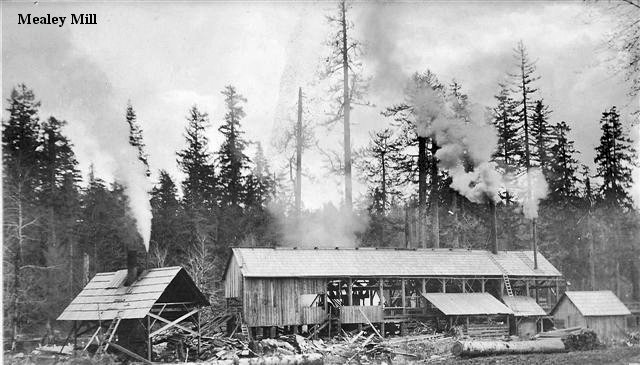
Judd and Bill owned a sawmill on Quartzville Road. Judd Mealey became a doctor, learning medicine from an Albany doctor who supplied medical books and instruction as well as practical applications. He worked helping the locals with minor ailments. He was a kind man who was seldom paid a fee, but worked to pay for the medicine he gave to his patients.
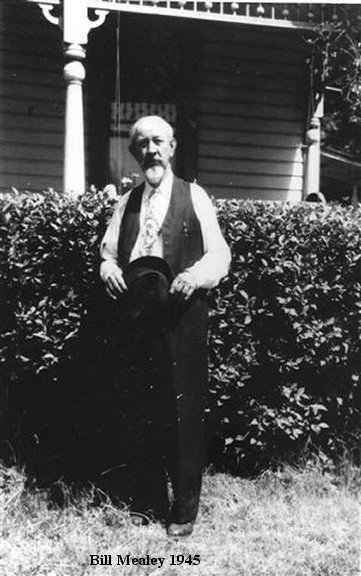 William (Bill) Mealey, Charles youngest
son, was very energetic and he became involved in the Linn County Fire Patrol,
an agency for fire protection and preservation of timber. Bill was also
remembered for his fine poetry. One time
Bill and Judd went to Alaska to make their fortune. Bill became ill and
it was fortunate that Judd had his medical skill. Then it was Judd’s turn; he came down with
scurvy, his hair turned white and he was laid up for a long time. They came home
empty-handed. The gold was left in Alaska. They returned to Mealey’s Sawmill, which they operated for 17 years before it
burned to the ground in 1924. They employed up to 20 men seasonally at the mill
and also men who cut the timber with crosscut saws. The dynamic duo bought 3,500 acres of
timberlands with their earnings.
William (Bill) Mealey, Charles youngest
son, was very energetic and he became involved in the Linn County Fire Patrol,
an agency for fire protection and preservation of timber. Bill was also
remembered for his fine poetry. One time
Bill and Judd went to Alaska to make their fortune. Bill became ill and
it was fortunate that Judd had his medical skill. Then it was Judd’s turn; he came down with
scurvy, his hair turned white and he was laid up for a long time. They came home
empty-handed. The gold was left in Alaska. They returned to Mealey’s Sawmill, which they operated for 17 years before it
burned to the ground in 1924. They employed up to 20 men seasonally at the mill
and also men who cut the timber with crosscut saws. The dynamic duo bought 3,500 acres of
timberlands with their earnings.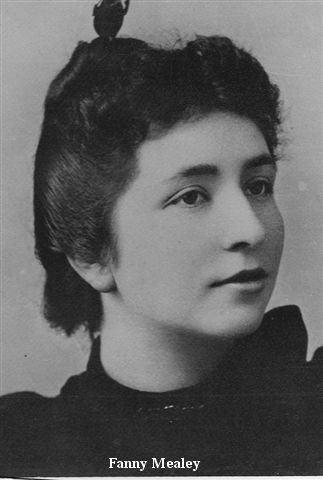
Bill Mealey married beautiful Fanny Rachel Hamilton; they had six children: David, George, Mary, Marguerite, Robert and baby Rachel. He built a house about six miles from Sweet Home. The lumber from their mill was rough, but he
used it for a fine two-story house with three bedrooms upstairs, and two on the
bottom floor with living areas around a stone fireplace. Tales of earlier days
were often shared beside the fireplace, especially one about Charles being shot
by an Indian on Charles’ first trip out to
Oregon.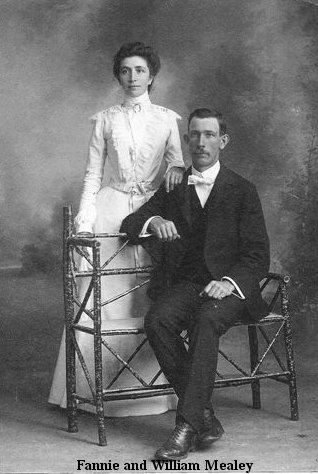
As their family grew, Hilda Geil came and helped with the children. In 1917, when their youngest child, Rachel, was seven days old, Fanny died. They laid her body out on a door. Bob Mealey was four and remembered following the wagon with mud on its wheels while his mother’s body was taken to Gilliland Cemetery.
Judd Mealey and wife Elsie Cox Mealey, a teacher, moved in with his brother Bill to help raise his children. Elsie had lost two children to diphtheria and had two living children, Orpha and Joy. A caring woman, she raised all eight Mealey children and never showed favoritism – they were all one family.
All of William’s children called Elsie
“Mom.” Friends were puzzled as to how they all could stay in one large house
together. Rachel reported at school, “My
mom sleeps with Uncle Judd upstairs in the master bedroom and my dad sleeps
downstairs.” This all made perfect sense to all the
children.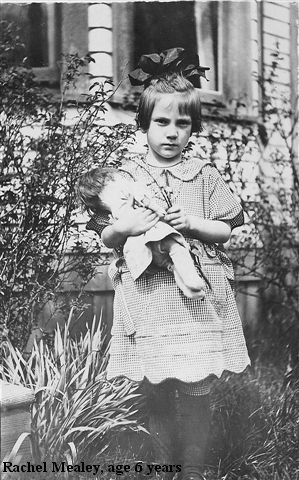
When tiny Rachel was sitting in her high chair, William gave her an encyclopedia to ruffle the pages. He said “She’s going to be a reader.” He was right; she became a librarian.
Rachel tells “when all of my siblings graduated, I needed a ride to school”. There were no school buses, so at 14, I learned to drive a motor car. The cars were primitive then, as were the roads. There were no gear shifts, just buttons on the floor board that made the car go forward, accelerate or go into reverse. No automatic window wipers, it was the duty of the passenger to operate the window wiper so I could see to drive. But first I needed to learn how to steer the foolish vehicle; it just wanted to go from one ditch to another. No one drove fast, and celluloid curtains protected us from the wind and rain.”
One day the two boys, George Jr. and Roy Jr. decided to do something memorable that the family would never forget. They awoke the next morning to a full stack of hay sitting in the middle of the living room. “Dad was unhappy about the prank,” Rachel recalls.
William (Bill) the Poet of the Santiam, would type away with all the eight children running around playing. He eventually finished a book of poetry. The New Era published 187 of his poems.
Brothers Judd and Bill were close but opposites in nature. They shared a real estate business with my great-grandfather John Thompson. Bill and Judd both died in 1948.
Bill’s youngest son, well-known Bob
Mealey, a graduate of the Oregon State University Forestry program, helped with
the family’s vast forest holdings. I remember going on excursions to some of
Bob’s park lands with a busload of visitors, having a tasty barbecue.
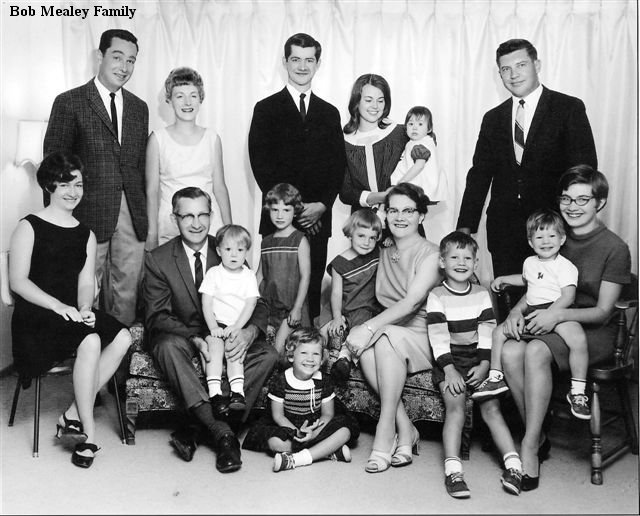
In 1959, Sweet Home chose Bob as its First Citizen at the Annual Chamber awards banquet. He was very civic-minded and chaired the school board through the controversial district consolidation in the 1950s. Family members said Robert Mealey was the guiding light of the Mealey family.
Bob married Anna and they had four children: William, named for his grandfather, who lives in Portland; Mary Kay in Kansas; Steven, also a retired forester, of Springfield; and Connie, who is deceased. Bob died April 2007, after a grand life.
Orpha and Joy married well. Orpha married rancher George Lines in Knox Butte; they had two children, Russell and Barbara Lines Hough. Joy married a pharmacist, Dan Brown of Dundee. Their children were Bob and Carol. Orpha died in 1976 and Joy in 1986.
David Mealey was born Sept. 15, 1903, the oldest child of Fanny and William. He and his friend, my Uncle Henry Thompson, went fishing and hunting together, especially at Fish Lake. David and Roy Norquist partnered in building roads. They built a road to Gilliland Cemetery and worked on the Santiam Highway. David was a high school athlete who played baseball; he graduated in 1922. David suffered from Buergers disease, which eventually took both legs, and he spent his days in a wheel chair. But he did his own housekeeping, as he never married. In 1965 he died, and is buried in Gilliland Cemetery beside the family.
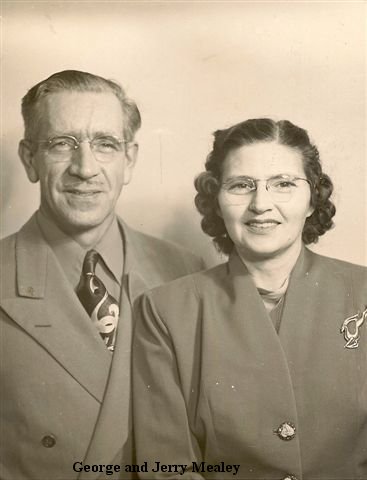 George
Mealey, while in high school, took his Model T Ford and worked on the car on the
school’s lawn with pretty girls atop the car. He was expelled. He was mechanical
and graduated from Portland Tech in 1925, becoming an engine mechanic for
Aleutian Airlines in Alaska. George married Jerry Heck
June 1, 1948 in Anchorage. They returned to Foster in 1957, building
a home on Quartzville
Road near the Lewis Creek Park. Rock hounding was their hobby and they
were active in the Rock and Gem Club.
George
Mealey, while in high school, took his Model T Ford and worked on the car on the
school’s lawn with pretty girls atop the car. He was expelled. He was mechanical
and graduated from Portland Tech in 1925, becoming an engine mechanic for
Aleutian Airlines in Alaska. George married Jerry Heck
June 1, 1948 in Anchorage. They returned to Foster in 1957, building
a home on Quartzville
Road near the Lewis Creek Park. Rock hounding was their hobby and they
were active in the Rock and Gem Club.
They left a legacy by funding the Sweet Home Genealogical Library. The Library is used daily by those searching for their ancestors. George died in 1989. He had two children from his first marriage, one of which, George Mealey Jr., is a mining engineer who is a national figure in the industrial world and lives in Louisiana.
Mary Mealey taught many years of elementary school locally, my brothers too. She also taught at Cascadia when that school was new. She married Darrell Simons and they were blessed with two children – Robert and Willa. Both now live in Washington. Darrell and Mary Simons owned the Golden Rule Planing Mill that stood next to Sankey Park until it burned.
With the exception of Rachel, 92, the children of William are gone. Many descendents live locally. Harry Rollins and Rachel were married 55 years when he passed away in 2002. Rachel’s three sons, Larry, 59, Gary, 56 and Kerry Rollins, 54, live away from this area. Rachel has four grandchildren and four great-grandchildren.
Petite Marguerite married Roy Holcomb. Their brown and white two-story house stands today near the Foster school. Marguerite Mealey Holcomb’s children are Roy, Marc, Dick, Monte, Jane Ann Hirschi and Kathleen Walker. She is remembered as a good person who didn’t have an easy life but always had a good sense of humor. Her six children remember she was fastidious, hard working and always made sure they had clean, well-pressed clothes for school each day. Her husband passed away in 1969.
Roy Jr. was born Dec. 15, 1934 and lives in the local area. Marguerite has 13 grandchildren, and passed away in 1993 at the age of 83. Her great-granddaughter, Josalyn Sky Mealey Kittson, is the sixth generation following Charles Mealey.
This talented large family has left their mark on our area. Rachel Mealey Rollins Vogel taught school locally; she taught my class in the third grade. She also was librarian and visual aids media specialist in this district throughout her career. After retiring, Rachel and Harry Rollins spent happy years in Hawaii, before he passed on. Just a few years ago, Rachel moved back into her home, which was moved to its present location when the dams were built in 1964-65. Eventually Bob Mealey restored their old home; the same large Mealey home that Judd, Elsie and William Mealey shared with their eight children.
Today, Rachel and husband, the retired Rev. Theodore Vogel of the Bethel Lutheran Church, and both still live there in this lovely home.
We are proud that this family called the Sweet Home area their home.
I’d Ruther Be A Farmer by Bill Mealey
I’d ruther be a farmer than to be a doctor
man.
I’d ruther leave the doctorin’ tu those who think they can,
I’d sooner foller day to day along behind a
plow
Than be a cuttin’ humans up;
I’m glad I don’t know
how.
When my time comes for passin’ out
I don’t want tu’ be in bed.
Out among my farmin’ ground
I’d ruther be found dead.
Lyin ther’ jist peaceful like among the grass and
trees
Wher’ I heerd the songs
uv
birds
An hummin’ uv the bees.
![]()
My name is Stephenie Flora. Thanks for stopping by. Return to [ Home Page ] All [ Comments and Inquiries ] are welcome.